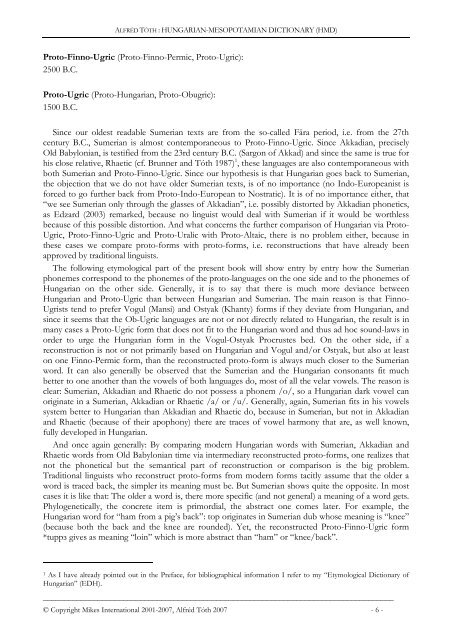Hungarian-Mesopotamian Dictionary (HMD)
Hungarian-Mesopotamian Dictionary (HMD)
Hungarian-Mesopotamian Dictionary (HMD)
You also want an ePaper? Increase the reach of your titles
YUMPU automatically turns print PDFs into web optimized ePapers that Google loves.
ALFRÉD TÓTH : HUNGARIAN-MESOPOTAMIAN DICTIONARY (<strong>HMD</strong>)<br />
Proto-Finno-Ugric (Proto-Finno-Permic, Proto-Ugric):<br />
2500 B.C.<br />
Proto-Ugric (Proto-<strong>Hungarian</strong>, Proto-Obugric):<br />
1500 B.C.<br />
Since our oldest readable Sumerian texts are from the so-called Fāra period, i.e. from the 27th<br />
century B.C., Sumerian is almost contemporaneous to Proto-Finno-Ugric. Since Akkadian, precisely<br />
Old Babylonian, is testified from the 23rd century B.C. (Sargon of Akkad) and since the same is true for<br />
his close relative, Rhaetic (cf. Brunner and Tóth 1987) 1 , these languages are also contemporaneous with<br />
both Sumerian and Proto-Finno-Ugric. Since our hypothesis is that <strong>Hungarian</strong> goes back to Sumerian,<br />
the objection that we do not have older Sumerian texts, is of no importance (no Indo-Europeanist is<br />
forced to go further back from Proto-Indo-European to Nostratic). It is of no importance either, that<br />
“we see Sumerian only through the glasses of Akkadian”, i.e. possibly distorted by Akkadian phonetics,<br />
as Edzard (2003) remarked, because no linguist would deal with Sumerian if it would be worthless<br />
because of this possible distortion. And what concerns the further comparison of <strong>Hungarian</strong> via Proto-<br />
Ugric, Proto-Finno-Ugric and Proto-Uralic with Proto-Altaic, there is no problem either, because in<br />
these cases we compare proto-forms with proto-forms, i.e. reconstructions that have already been<br />
approved by traditional linguists.<br />
The following etymological part of the present book will show entry by entry how the Sumerian<br />
phonemes correspond to the phonemes of the proto-languages on the one side and to the phonemes of<br />
<strong>Hungarian</strong> on the other side. Generally, it is to say that there is much more deviance between<br />
<strong>Hungarian</strong> and Proto-Ugric than between <strong>Hungarian</strong> and Sumerian. The main reason is that Finno-<br />
Ugrists tend to prefer Vogul (Mansi) and Ostyak (Khanty) forms if they deviate from <strong>Hungarian</strong>, and<br />
since it seems that the Ob-Ugric languages are not or not directly related to <strong>Hungarian</strong>, the result is in<br />
many cases a Proto-Ugric form that does not fit to the <strong>Hungarian</strong> word and thus ad hoc sound-laws in<br />
order to urge the <strong>Hungarian</strong> form in the Vogul-Ostyak Procrustes bed. On the other side, if a<br />
reconstruction is not or not primarily based on <strong>Hungarian</strong> and Vogul and/or Ostyak, but also at least<br />
on one Finno-Permic form, than the reconstructed proto-form is always much closer to the Sumerian<br />
word. It can also generally be observed that the Sumerian and the <strong>Hungarian</strong> consonants fit much<br />
better to one another than the vowels of both languages do, most of all the velar vowels. The reason is<br />
clear: Sumerian, Akkadian and Rhaetic do not possess a phonem /o/, so a <strong>Hungarian</strong> dark vowel can<br />
originate in a Sumerian, Akkadian or Rhaetic /a/ or /u/. Generally, again, Sumerian fits in his vowels<br />
system better to <strong>Hungarian</strong> than Akkadian and Rhaetic do, because in Sumerian, but not in Akkadian<br />
and Rhaetic (because of their apophony) there are traces of vowel harmony that are, as well known,<br />
fully developed in <strong>Hungarian</strong>.<br />
And once again generally: By comparing modern <strong>Hungarian</strong> words with Sumerian, Akkadian and<br />
Rhaetic words from Old Babylonian time via intermediary reconstructed proto-forms, one realizes that<br />
not the phonetical but the semantical part of reconstruction or comparison is the big problem.<br />
Traditional linguists who reconstruct proto-forms from modern forms tacitly assume that the older a<br />
word is traced back, the simpler its meaning must be. But Sumerian shows quite the opposite. In most<br />
cases it is like that: The older a word is, there more specific (and not general) a meaning of a word gets.<br />
Phylogenetically, the concrete item is primordial, the abstract one comes later. For example, the<br />
<strong>Hungarian</strong> word for “ham from a pig’s back”: top originates in Sumerian dub whose meaning is “knee”<br />
(because both the back and the knee are rounded). Yet, the reconstructed Proto-Finno-Ugric form<br />
*tuppз gives as meaning “loin” which is more abstract than “ham” or “knee/back”.<br />
1 As I have already pointed out in the Preface, for bibliographical information I refer to my “Etymological <strong>Dictionary</strong> of<br />
<strong>Hungarian</strong>” (EDH).<br />
___________________________________________________________________________________<br />
© Copyright Mikes International 2001-2007, Alfréd Tóth 2007 - 6 -








![Letöltés egy fájlban [4.3 MB - PDF]](https://img.yumpu.com/50159926/1/180x260/letaltacs-egy-fajlban-43-mb-pdf.jpg?quality=85)








